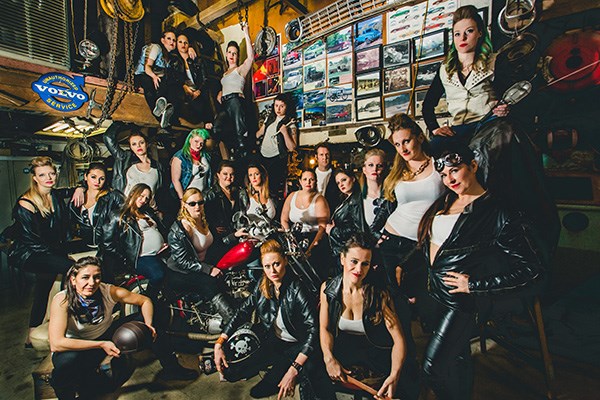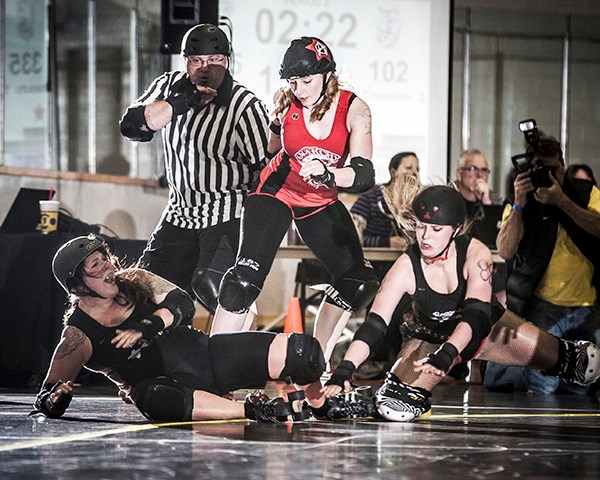Shannon “Mala Justed” Handley wants to dispel some misconceptions about her sport of roller derby.
It’s much different than the derby of the past, for one thing, she says. Back in the 1970s – the days of the formidable Gwen “Skinny Minnie” Miller – elbows flew and so did the players, over the boards and each other.
“It isn’t really like that at all anymore,” said Handley, founder of the Squamish roller derby team the Sea to Sky Sirens.
Modern roller derby is much more strategic than the historic derby.
“One of the common expressions among people who play roller derby is it is like high-speed chess while bricks are thrown at you,” she said. “It just blows your mind, what some of these people can do physically and command mentally at the same time.”
For the uninitiated, derby bouts last for one hour, with two 30-minute periods.
Teams have five women a side: three blockers, one pivot and one jammer.
Handley doesn’t have a defined position, she said – she plays them all.
Each period is made up of multiple jams, which last up to two minutes. In a jam, players simultaneously skate counterclockwise around the “flat track,” or rink. The aim of each jam is to score as many points as possible by the jammer lapping a member of the opposing team. The members of each team try to prevent the other team’s jammer from passing and help their own jammer score.
The full-contact, fast-paced sport played on old school roller skates isn’t for the timid. In fact, a Helsinki painter, Riikka Hyvönen, based an entire art exhibition on the “beauty” of real-life roller derby bruises, affectionately called “derby kisses” by players.
The bruises form deep purple, blue and yellowish-green swirls on various derby players’ body parts where they collided with an opposing player or the concrete track.
Before a player can join the team, she has to go through a “Fresh Meat” program where she learns to master roller-skating, the physical demands of the game and the rules.
Players must pass a physical and written test to make the team.
“It is intense,” said the Sirens’ youngest player, Tawnie Gillis, a diminutive 23-year-old college student and second-year blocker.
She’s known as “Tawnka Truck” in the derby world. “It is a play off of Tawnie and the little truck, tough thing,” she explained.

A misconception is that derby women are hulking brutes, according to Handley.
“You don’t have to be big,” she said. “I have seen tons of tiny players really dominate this sport.”
A diverse group of 23 women make up the Squamish team, which began in 2008 with six women meeting to skate on whatever flat surface they could find. Women of all shapes, sizes, ages and backgrounds play derby.
Sirens veteran Handley, 32, is an electrician by trade.
Jessie Cameron, who plays jammer and blocker, is a 31-year-old lawyer known as “Purr-Fect-Lee-Legal.”
“Lawyers need hobbies too,” Cameron joked.
The strategy, ruggedness and personas they wear on the track are empowering outlets for women, many said.
Derby portrays a positive female body image.
“I have always been athletic. I’ve put on more muscle though doing this sport than I did… snowboarding, or mountain biking or running,” said Cameron. “It is good, it feels good to be strong.”
Several women on the team are mothers. Lindsay Leathem, 39, is a wife, mother of two and account manager at a radio station. On the track, however, she’s jammer Rowdy Roddy Pippa.
“Having something like derby, or having something where you have this ultra ego where you aren’t just somebody’s mom – as much as that is OK… it is nice to have an identity and be like, yeah, I am tough,” she said.
More than anything, the Sirens seem a tribe of sorts, with an unbreakable sisterhood that bonds them.
“Lifelong friends,” asserted Leathem, who joined the team in 2012 when she moved to Squamish from Pemberton.
“All of us have had losses in our families… we’ve had girls who have been injured, and everybody steps up,” she said. “You’ve got happily married women, you’ve got divorced women, you’ve got women who like women, it doesn’t matter, everybody just gets on the track and has fun and has this amazing sisterhood.”
In February, when Gillis had all her gear stolen from her truck, the team rallied around her and presented her with money and gear to replace what was stolen.
“We really stick up for each other,” Gillis said.
Handley said it has been an amazing feeling to see the ragtag team she started over eight years ago grow up. The team began in 2008.
In 2010, the not-for-profit Squamish Women’s Roller Derby Association, of which the Sirens are a member, was formed. “I’m honoured. It’s pretty special,” she said. “It’s a lot of work, but there are a lot of rewards.”
This season will be a little different because, with the arena slab at Brennan Park being replaced, it is out of commission; no home bouts are scheduled.
The Sirens are slated for a high-profile bout during the renowned 2016 World Ski and Snowboard Festival in Whistler on April 9.
Typically, the team draws a few hundred devoted fans to its family-friendly home games, Handley said.
She would like to see the fan base grow once the Sirens’ bouts are back on home turf next season.
“I think one of the reasons why it hasn’t broken into the mainstream… is people don’t know the rules,” Handley said. “It is really hard to watch a sport if you can’t understand why is this person getting a penalty, why are they doing this weird thing. So it is definitely something we struggle with. You are trying to gain a fan base and try and to educate them about the sport at the same time…. More than anything, I wish they didn’t misunderstand it.”
For more on the team, go to www.squamishrollerderby.ca.




